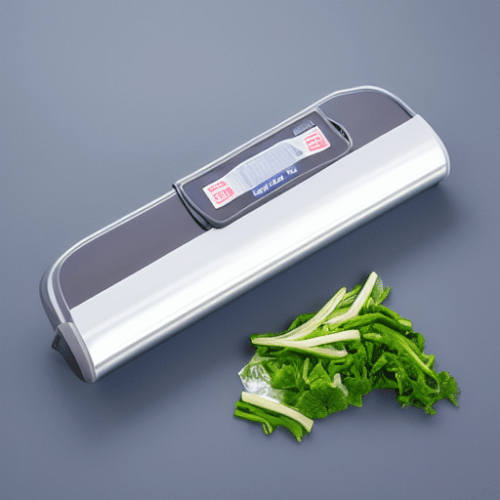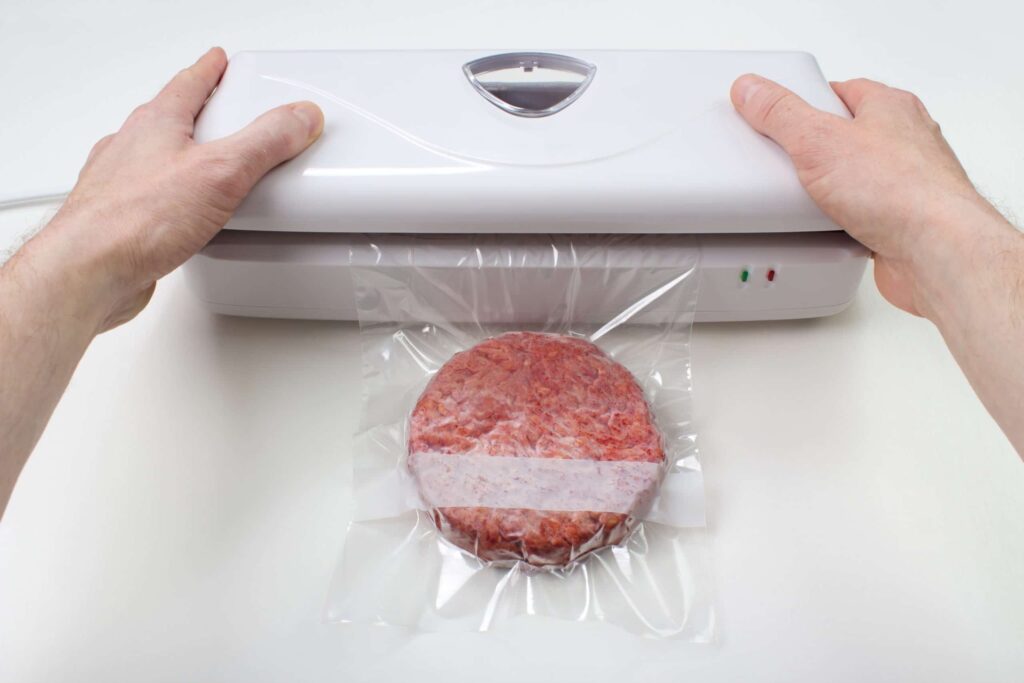Last Updated on
Have you ever wondered how to use a vacuum sealer correctly?
Maybe you’re sick of the food in your home going out of date before you’ve had a chance to use it, and you want a better way to preserve what you buy. Perhaps you’ve been looking into vacuum seal bags to help protect your clothing when they go into storage or to save space in your cupboards.
Vacuum packing is a fantastic tool for any household, but it’s important to make sure you’re leveraging your vacuum sealer machine correctly. That’s why we’re putting together this guide on how to use a vacuum seal product as effectively as possible.
Whether you’re using a handheld vacuum sealer or a full-sized vacuum sealer machine, the following tips will help guide you in the right direction.
Using a Vacuum Sealer
Using a vacuum sealer is quite simple to accomplish once you know how. Here is a step-by-step guide when using a vacuum sealer:
Step 1: Get the Right Bag
The first step to successful vacuum sealing is choosing the right vacuum bag. As mentioned above, there are vacuum sealers for just about everything these days, from salad mixes and potato chip bags to bags that have absolutely nothing to do with food storage. For instance, you can use huge vacuum bags to store your winter clothes or accessories for fishing trips.
Although there are tips and tricks out there for using any bag with your vacuum sealer machine, the reality is that dedicated vacuum sealer bags will always be more effective. These bags feature a unique design and seal function, which are excellent for keeping all the air away from your food.
Most of the time, vacuum sealing machines come with advice on the kind of bags you can use with your oxygen absorber to get the right results. Look into the bag options available for your needs, and you’ll need to think about the following:
The Size
The size of your vacuum-sealed bag is important. If you’re sealing away smaller portions, a smaller bag will take up less space in your freezer or pantry. If you want to vacuum-seal a large bag of meat and fish, on the other hand, you’ll need a different kind of bag – one that’s capable of holding more ingredients.
The Structure
Many vacuum sealer machines are designed to work with all kinds of containers. You can use a bag when you next post comic books to a friend when you want to protect them from water damage. Bags are also great for sealing away dry goods like vegetables and pasta or grains. If you’re sealing liquids, you might want to look into jars and pots for vacuum sealing to help keep them fresh.
What It Can Hold
The best vacuum-sealed bag or container will be able to hold up to the pressure when you use your vacuum sealer. Check what kind of weight the product can hold and whether the bag is suitable for freezing. You might also want to look into the strength of the container if you’re sealing a sharp object (like pasta with sharp edges).
Step 2: Prep Your Food or Supplies

Once you have your vacuum sealing supplies, and a bag or container that’s ready for a good seal, you’ll need the products you want to vacuum seal. As mentioned above, you can seal all kinds of things in the right container or bag, from food that you want to keep fresh longer to brown sugar, emergency kits for emergency preparedness and more.
Everything you seal with a vacuum sealing machine will need to be prepared in a certain way. For instance, if you’re vacuum-sealing fish and meat, then you might want to cut the food down into smaller portions and get rid of anything you wouldn’t want to cook, like fat.
This way, you can immediately thaw the meat from the freezer and add it to the grill when you’re ready. If you’re vacuum-sealing dry ingredients with sharp edges, like meat with bones, or uncooked pasta, you’ll need to wrap the product you’re sealing in something first.
Placing a secondary bag or some kitchen roll around the sharp objects you want to vacuum pack will help to protect the sealer bag from damage. If you’re vacuum-sealing liquids, then it’s best to freeze the liquids in another bag before you put them in your vacuum-sealed bags. This will help to avoid making a mess when you’re in the midst of the vacuum process.
Fill the bag properly, making sure you don’t go too over the top. Adding too much food or other items to a vacuum seal bag could cause it to split.
Step 3: Begin the Vacuum Seal
With your products ready in your vacuum bag, you’re ready to retrieve your vacuum sealer. This product should come with some basic instructions on using it, but most solutions follow a similar process. Start by laying the vacuum sealing bag on the counter and open the top of the vacuum sealer. You should be able to place the bag opening on the bar sealer strip.
Remember, don’t place the bag on the vacuum channel, as you’ll need to close the machine’s lid tightly to begin the process. Click the button on the chamber sealer side to begin the process. Most units will let you know when they’ve removed as much air as possible by automatically turning off or using an LED light.
More advanced vacuum sealing machines might have specific settings you can experiment with to improve the shelf life of your food. You can take some time to experiment with different options if you want to make sure you’re getting the most out of your investment.
Once you’re done sealing away your coffee beans, clothes, and other products, make sure your vacuum cleaner is fully clean. You can wipe it over with a damp dishcloth to get rid of any dust or excess debris. Place your sealer in a safe location when you’re done with it. This will ensure the only way your sealer will get dirty is when you use it.
Tips for Using Your Vacuum Sealer
The more confident you get with your vacuum sealer, the easier it will be to save money by storing larger quantities of food and other items. If you want to free up space in the fridge or need more options for freezing food whenever you cook meat and have too much leftover after an occasion, a reliable vacuum sealer can be a fantastic purchase.
Here are some top tips for using your vacuum sealer correctly:
Cushioning
Use wax paper and other bags as cushioning when you’re using a sous vide sealer to preserve foods and items with sharp edges. This will help to stop the bag from splitting. Don’t waste money by using more than one vacuum bag unless you need to.
Store Food Correctly
After sealing your food, make sure you know where to store them properly. Dry foods can often go in a pantry or cupboard, while meat needs to be stored in the freezer. Make sure to use your chamber sealer to make the ingredients last longer.
Reseal Food Packages
You can use your vacuum sealer to remove the air from food packages you’ve already opened if you haven’t used everything at once. Adding a new seal can be a great way to make food last longer.
Experiment With Bags and Jars
As mentioned above, you can use bags, jars, and all kinds of containers with a sealer. Take some time to find out what kind of containers work best for each sealing session.
Cook Meat
You can get all kinds of amazing five-star meals when you use your sealer to help preserve the meat you get from the butcher and keep it as fresh as possible. Make sure you start with quality ingredients, though.
Store Clothes With a Vacuum Sealer
Travel hack for heavy packers ✈️✨ Get a portable vacuum sealer and you can take nothing but a carry on with you! In here is 7 days of clothes + swimsuits + pajamas #ThankMeLater pic.twitter.com/CR75wizdNv
— Jasmine (@jasmine_lc) February 22, 2020
Protecting your clothes from air, moths, and dirt is a great way to ensure they last as long as possible. You can even keep washed clothes fresh for different seasons if you won’t be wearing them for a while.
Protect Documents With Your Sealer
You can vacuum seal a previous post-delivery or important documents to protect them from water and other kinds of damage. This is a great service to perform before you place your documents in a safe.
Vacuum Seal Precious Items
If you have a selection of antique documents, books, or items that might lose their quality over time when exposed to the elements, vacuum sealing can make them last longer.
Its Vacuum Sealing Time
As you can see, a vacuum sealer is a quality investment, and it’s not just for preserving your favourite food. Removing the air from a bag or container you use to store all kinds of products can help to protect them against damage for extended periods. Once you learn how to use a vacuum sealer correctly, you can quickly branch out and start exploring the benefits of sealing more than just food products.
Rebekah is a writer who loves to explore new products and find hacks that make life easier. She has a knack for all things home improvement, health and fitness. So you’ll often find her on Pinterest or browsing Houzz for ideas.
She’s always looking for the next thing to fix up around the house or what gadget might be just right for her lifestyle. Rebekah enjoys exploring new recipes, taking care of her family, and making sure she stays healthy with regular workouts at the gym.



